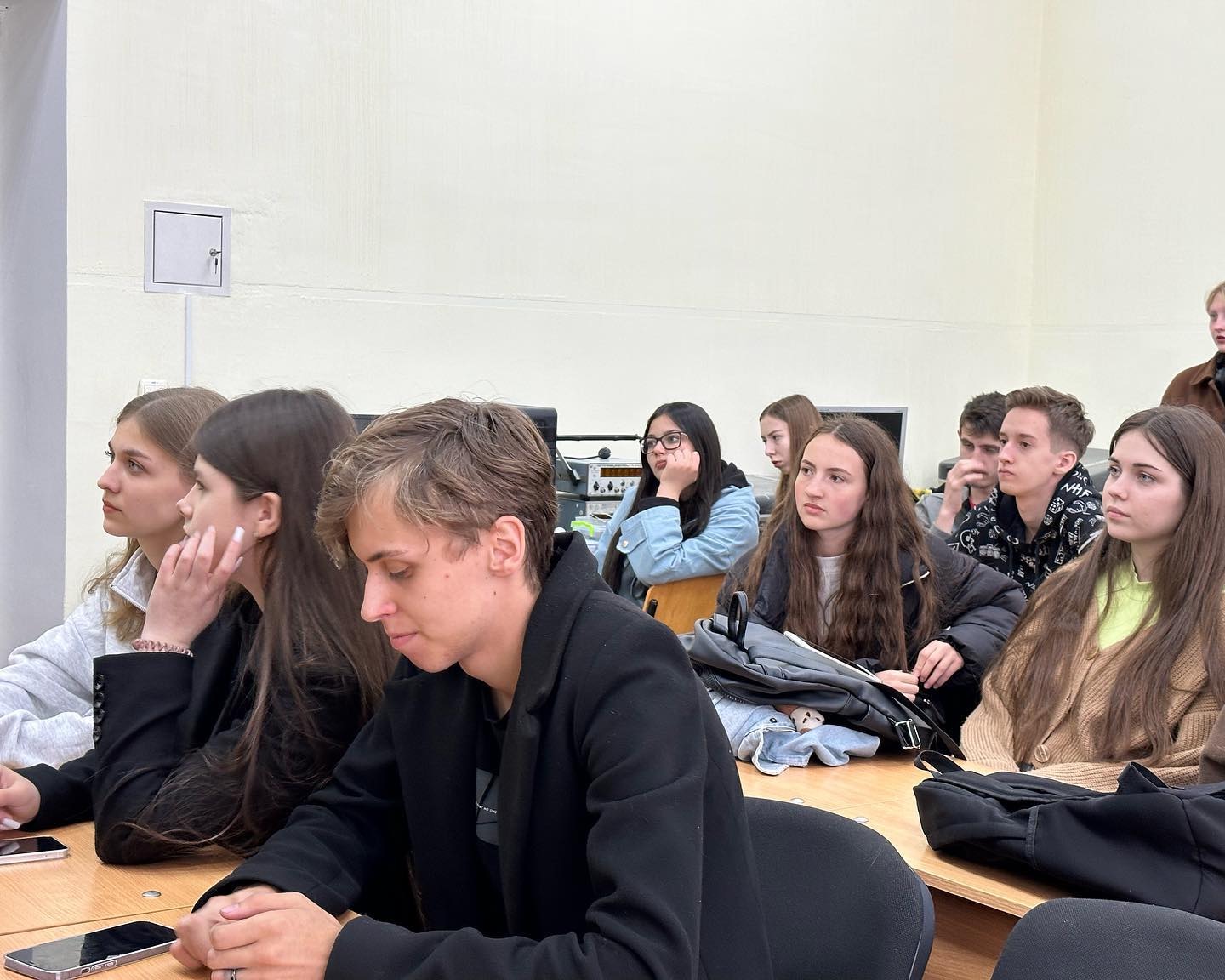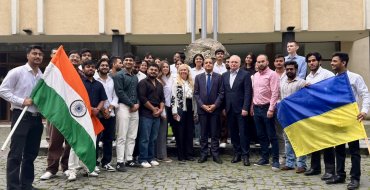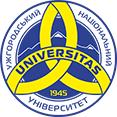The Faculty of Physics is preparing a new generation of specialists - those who will shape the technological future of Ukraine
7 May is Physicist's Day in Ukraine.This day is a symbol of gratitude to all those who work to uncover the secrets of the universe, study natural phenomena and their interaction.Thanks to their scientific achievements, humanity has received answers to complex questions and made a huge step into the future.Already in 1946, the Department of Physics and Mathematics was opened at the newly established Uzhhorod University to provide the educational process in physics and mathematics at the Faculties of Biology, Medicine and Chemistry, and in 1966, the Faculty of Physics began its history as a separate unit.In a conversation with the Dean of the Faculty of Physics, Professor Volodymyr Lazur, we will talk about the modernity of the Faculty of Physics - what kind of specialists it trains, employment opportunities and innovations.

- What specialities are represented at your faculty?
- First of all, I would like to note that the Faculty of Physics of UzhNU has a glorious history, which includes more than 75 years of fruitful work in the field of education and science. The educational process at the Faculty of Physics is provided by 17 professors, doctors of sciences and 47 associate professors, candidates of sciences, including one academician of the National Academy of Sciences of Ukraine, three laureates of the State Prize of Ukraine in Science and Technology of Ukraine, five honoured workers of science and technology of Ukraine, one Honoured Worker of Education of Ukraine and two Honoured Inventors of Ukraine. Highly qualified employees of the Research Institute of Solid State Physics and Chemistry and the Institute of Electronic Physics of the National Academy of Sciences of Ukraine, who are the pride of the national science, are also involved in the educational process. The faculty's adequate material and technical base contributes to the successful study and research work of students.
The Faculty of Physics trains bachelors in 7 specialities:
A4.08 - Secondary education. Physics and Astronomy (EP Physics. Informatics)
E5 - Physics and Astronomy (EP Physics and Astronomy)
E6 - Applied Physics and Nanomaterials (EP Applied Physics and Nanomaterials)
F5 - Cybersecurity and information protection (EP Security of information and communication systems)
G5 - Electronics, Electronic Communications, Instrumentation and Radio Engineering (EP Telecommunications and Radio Engineering)
G5 - Electronics, electronic communications, instrumentation and radio engineering (EP Micro- and nanoelectronics)
G22 - Biomedical Engineering (Programme Biomedical Engineering)
The Faculty of Physics trains masters in 6 specialities:
A4.08 - Secondary education. Physics and Astronomy (EP Physics. Informatics)
E5 - Physics and Astronomy (EP Physics and Astronomy)
E6 - Applied Physics and Nanomaterials (EP Applied Physics and Nanomaterials)
F5 - Cybersecurity and information protection (EP Security of information and communication systems)
G5 - Electronics, Electronic Communications, Instrumentation and Radio Engineering (EP Optoelectronic Telecommunication Systems)
G5 - Electronics, Electronic Communications, Instrumentation and Radio Engineering (EP Physical and Biomedical Electronics)
The best graduates of the Faculty have the opportunity to continue their postgraduate studies to obtain a Doctor of Philosophy degree in two specialities: ‘Physics and Astronomy and Applied Physics and Nanomaterials.
Studying at the Faculty of Physics of UzhNU is prestigious and honourable. Here you can get a high-quality international higher education, work on modern high-tech equipment, listen to lectures by famous physicists, many of whom are globally recognised and are actively working in science today. Every year, physics students have the opportunity to study and undertake internships at European universities, participate in international research programmes, including in cooperation with CERN, ESA, Horizon Europe, etc.
- In your opinion, why are the above-mentioned specialities relevant in 2025?
- A decent future for humanity is closely linked to the progress of physical science. The past twentieth century was certainly the century of physics: lasers, masers, X-rays, nuclear energy, personal computers, colour and digital television, mobile communications, the World Wide Web, and much, much more have appeared in the world thanks to the discoveries of physicists. And there is no doubt that physics will continue to be the main driver of scientific and technological progress in the 21st century. This is due to the very structure of physics as a science. Knowledge of the logic of nature is important not only for physicists, it is necessary for all areas of human activity. In the 21st century, humanity is facing a number of global challenges: controlled fusion, high-energy physics (i.e., a new generation of accelerators), dark matter and dark energy, quantum computers and artificial intelligence, the creation of new semiconductor substances with predetermined physical properties, the study of the fundamental properties and structure of matter and the evolution of the Universe since its birth, new space research programmes, and global environmental monitoring. Global problems also include the depletion of natural resources, environmental pollution, deadly diseases, and anthropogenic climate change. The natural sciences, which widely use physical research methods, should play a crucial role in solving the above problems.
It is appropriate here to recall in a little more detail the most significant and surprising scientific discoveries of physicists in the century that humanity has just entered. One of the greatest triumphs of particle physics was the discovery of the Higgs boson at the Large Hadron Collider (CERN, Geneva) in July 2012. This particle helps to explain why all other particles in the Universe have mass, and its discovery completed the creation of the so-called Standard Model, a theoretical concept that describes all known fundamental particles and their interactions. In mid-December 2022, scientists at the Lawrence Livermore National Laboratory (California, USA) announced that they had conducted the first controlled fusion experiment, which resulted in the release of significantly more energy than was used to launch it. U.S. Department of Energy Secretary Jennifer Granholm called this breakthrough ‘one of the most amazing scientific discoveries of the 21st century,’ along with the Wright brothers' first flight in 1903.

Another significant breakthrough in physics and astronomy in the early 21st century was the discovery of gravitational waves, which propagate at the speed of light and occur in massive cosmic events such as the merger of two black holes. The discovery was made with the help of the Laser Interferometer Gravitational-Wave Observatory (LIGO). On 14 September 2015, a gravitational wave signal caused by the merger of two black holes at a distance of about 1.3 billion light years from Earth was recorded. This discovery confirmed the predictions of Albert Einstein's general theory of relativity and opened a new branch of astrophysics - gravitational astronomy. Gravitational waves provide us with a unique opportunity to study black holes, neutron stars and other cosmic objects that do not emit electromagnetic radiation. The discovery of gravitational waves has great potential for understanding the nature of the Universe, its origin and evolution. It has also provided new opportunities for testing physical theories, including the quantum theory of gravity.
In February 2022, the launch of the James Webb Telescope (worth $10 billion) revealed vivid images of the dark corners of the galaxy. According to Popular Science magazine, which named this event the innovation of the year in aerospace technology, the Webb telescope ‘can see deep fields of star formation’ and look ‘13 billion years back into ancient galaxies that are still in their primordial state’. Since its launch, the James Webb Space Telescope has found the oldest galaxy in the visible Universe, and has also taken photographs of the Kiel and South Wheel nebulae, the Stephen's Quartet galaxy collection, and a spectrum of light from the exoplanet WASP-96b.
During 2000-2010, a significant breakthrough was made in the study of dark energy and dark matter, the mysterious components of the Universe that make up the majority of its mass but do not interact with light and electromagnetic forces. Studies of these phenomena have revealed the infinity of the Universe and its expansion, which is accelerated by dark energy. These discoveries expand our understanding of cosmology and the importance of the invisible components of the Universe.
These and many other topical issues of modern physics cannot but interest ambitious young people. I would like to say to young people who have decided to pursue a career in physics that they have chosen a wonderful path that involves learning about the amazing mysteries of nature. On this path, the most important things are self-belief, dedication, and perseverance, and then success will come sooner or later. Science is fascinating because each new step on the path of knowledge can lead to unexpected innovations that create a new quality of life and affect all areas of human activity.
The mission of the UzhNU Physics Faculty as a classical physics faculty can be realised only by ensuring high quality education and research, their inextricable integration into the world science and combination with innovative activities. Our educational programmes, which we are constantly improving, are aimed at training an erudite, competitive specialist with a wide range of skills and a realistic employment prospect. Ukraine already needs highly professional specialists in knowledge-intensive industries and their further involvement in the real sector of the economy.
The development of new scientific research areas has led to the opening of new specialities at our faculty: ‘Electronic Communications and Radio Engineering and Biomedical Engineering and specialisations, including Nuclear Physics and High Energy Physics. The number of people willing to become specialists in these specialities is growing every year. Their opening was facilitated by the long-term research work of the faculty departments in the following areas: ‘Research of quantum mechanical systems for processing, transmission and protection of quantum information’ and “Study of elementary processes of interaction of electrons, photons and ions with biomolecules and biomaterials”.
One of the priority areas of the Faculty of Physics of UzhNU is fundamental and applied research to create a new generation of functional semiconductor materials and structures, which are of strategic importance for the development of the microelectronics industry and determine the level of scientific and technological progress of the country. Therefore, one of the key priorities of the Faculty of Physics of UzhNU is to train highly qualified specialists in the fields of micro- and nanosystems engineering, optoelectronics, applied physics and nanomaterials. The Faculty of Physics is training a new generation of specialists - those who will shape the technological future of Ukraine.
The presence of nuclear weapons or nuclear power is now one of the most important factors that can be used to assess the military or industrial potential of a country. There are now countries, including Ukraine, where the nuclear component of electricity generation has reached or exceeds the heat and hydroelectric components, and even more so the contribution from alternative energy (e.g. wind or solar). The vast majority of nuclear physicists and power engineers (including domestic ones) have no doubt that in the near future humanity will not be able to move away from the intensive development of this industry, as the traditional and most widely used energy sources - coal, oil and gas - are generally limited, albeit in different ways over time. This clearly implies that nuclear physics and nuclear engineering should remain among the priorities of the scientific field, because history, present and current trends in all spheres of human activity indicate an inevitable increase in energy consumption. Therefore, the role of universities and physics faculties that train specialists in the relevant field (i.e., in Nuclear Physics and High Energy Physics) will only grow. Uzhhorod physicists have at their disposal a unique electron accelerator complex (M-10 microtron and B-25 betatron for 10 MeV and 25 MeV, respectively), which has no analogues in Ukraine today. Along with fundamental studies of long-lived isomeric states of nuclei and photon reactions, researchers at this accelerator complex pay considerable attention to the introduction of nuclear physics methods into related fields of science and technology. The successful development of the above-mentioned research at the UzhNU Physics Department contributed to the creation of the third nuclear research centre in Ukraine (after Kharkiv and Kyiv), recognised in scientific circles. Graduates of the specialisation ‘Nuclear Physics and High Energy Physics’ (which is part of the speciality E5 - Physics and Astronomy) can work at nuclear power plants, in radiological laboratories and as scientists in research institutes.

The medical application of these nuclear processes for the needs of humanity is also promising to be important, as it is one of the most effective means of combating many incurable diseases, which in turn requires the training of highly qualified engineers, technologists, roboticists, and scientists. There is already a huge demand for new specialists in biomedical engineering, with different levels of qualification: bachelor's, master's, and doctoral degrees.
Physics is the basis of the country's defence capability. Without physicists, there will be no one to design combat missiles, electronic warfare (EW) equipment, original aircraft and other devices to protect the country. Modern warfare is a war of technologies. And they are created by researchers, developers and scientists all over the world. They do not hold weapons, but they help defend Ukraine with their knowledge and actions. Moreover, the high demand for technical developments and research in various areas of modern physics and new technology will encourage additional investment in the education sector. All of the above is impossible without quality education. Therefore, reforms in education are inevitable. It follows that the position of a teacher or lecturer will once again become prestigious and make educators competitive in the labour market.
- Please tell us about the novelties of this year's admission campaign at your faculty.
- As we observe the development of modern Ukrainian society, we see that our country's manufacturing industry needs capable, meticulously educated engineering staff. They must have a fundamental basic training in physical and mathematical disciplines and, at the same time, knowledge and skills in solving innovative scientific and technical problems. This is especially true in the fields of knowledge-intensive technologies, such as the development of the latest systems for recording, reading, protecting and transmitting information over long distances, including quantum teleportation. The scientific achievements of the specialists of the Departments of Optics and Theoretical Physics prompted us to open a new speciality - Telecommunications and Radio Engineering.
The successful development of scientific research at the Departments of Quantum Electronics and Semiconductor Physics on the study of microbiological objects and elementary processes occurring in living tissues under the influence of low-energy radiation led to the opening of another new speciality at the Faculty of Physics - Biomedical Engineering (BME). This interdisciplinary speciality emerged at the intersection of three sciences - physics, medicine and biology. It combines the sciences of animate and inanimate nature, and is based on a whole range of scientific and technical achievements and developments in the field of physical and technical sciences, medicine and biology. The main task of biomedical engineering is to solve a number of problems arising from the study of living objects and the design of technical systems for diagnostics, monitoring and treatment, rehabilitation and prevention of human diseases based on the fundamental principles of molecular and cellular biology.
- What employment opportunities are available to graduates?
- A characteristic feature of university physics education is its breadth, which allows a graduate of the Faculty of Physics of UzhNU to be freely and competently orientated not only in the field of physics, but also in any other field of human activity. The doors of the most prestigious academic research institutions, leading universities and secondary schools, design bureaus, research and production and computing centres, enterprises and organisations engaged in the development of information transmission and protection systems are open to physicists who have been educated at the Faculty of Physics of UzhNU. Students of our faculty, even before graduation, are invited to work by the leading enterprises of the region: Jable Circle Ukraine, PJSC Eurocar, UAP Fisher-Mukachevo, Yazaki Ukraine, Flextronics LLC and others. Our graduates are also successfully working in other fields: medicine, ecology, economics, finance, business, management, customs service, and law enforcement agencies.














